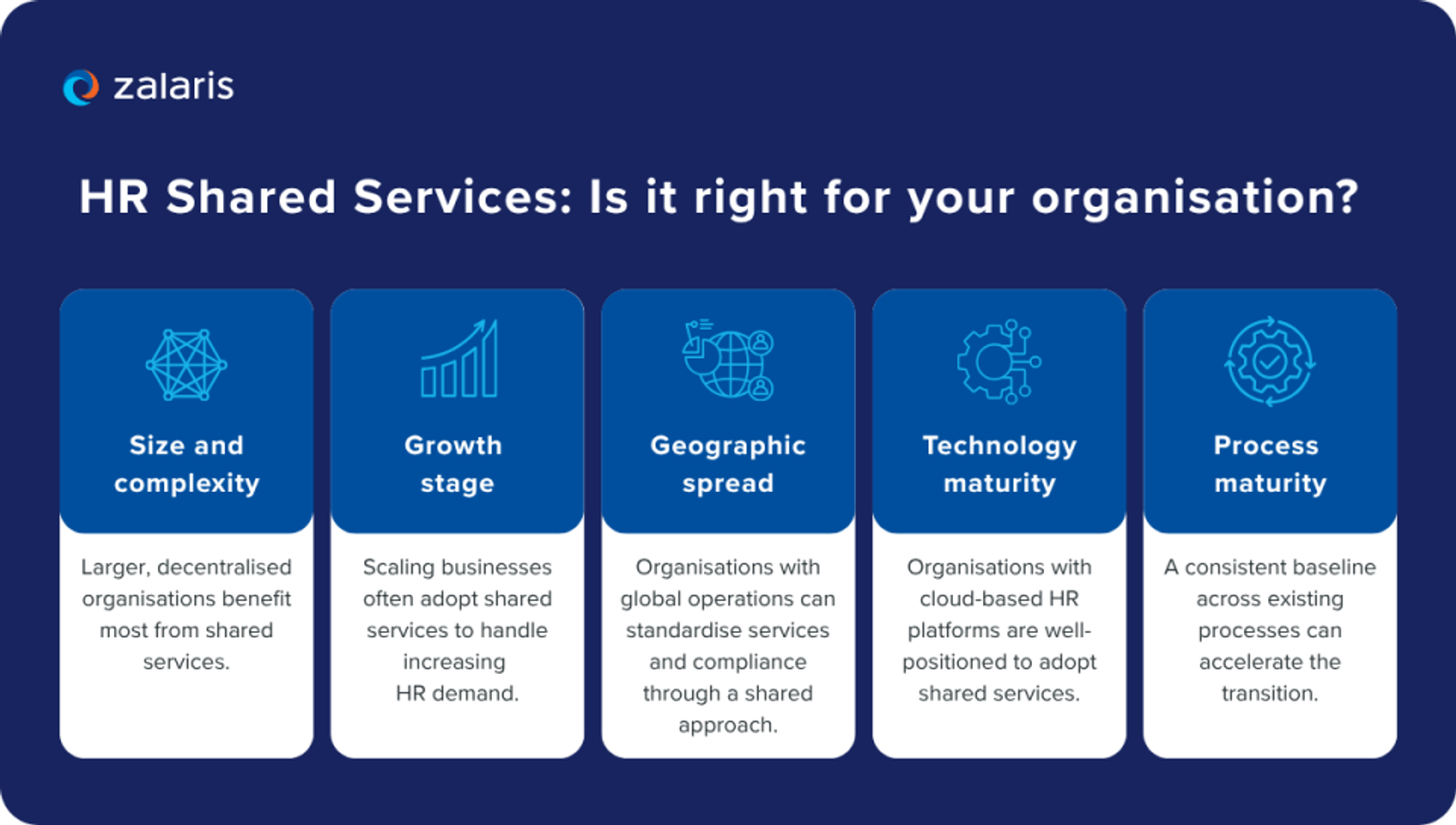HR Shared Services explained: Benefits, functions, and best practices
HR shared services have evolved into a cornerstone of modern HR operating models, enabling organisations to drive both efficiency and value creation at scale. Far from being just a cost-control tactic, this unique model helps organisations simplify delivery, enhance compliance and ensure consistent employee experiences across geographies.
Elliot Raba

As employees and organisations increasingly expect scalable, people-centred services that support strategic growth, HR shared services are transforming how organisations balance operational efficiency with strategic HR delivery.
The 2024 ScottMadden Benchmarking Report reveals that leading organisations service upto 456 full-time employees with just one shared service staff member. This underscores the model’s scalability and effectiveness. Notably, two-thirds of organisations using HR shared services are prioritising multifunction shared service models. This highlights a clear shift toward integrated, agile, and future-ready HR operations.
This article delves into the fundamentals of HR shared services, examining how the model operates in real-world settings, its primary advantages, and how to determine if it aligns with your organisation’s needs.
What are HR shared services?
HR shared services refer to a centralised unit that manages routine HR processes and organisational transactions. These often include payroll, benefits administration, employee data management, onboarding, and helpdesk support. Rather than duplicating these services in every region or business unit, shared services consolidate them into one location or digital platform.
Shared services are becoming increasingly common in the HR landscape as organisations look for ways to modernise, reduce complexity, and enhance the employee experience. According to Deloitte, over 80% of large organisations have adopted some form of shared services, highlighting the maturity and broad acceptance of the model. This shift from traditional, decentralised HR functions to centralised service delivery reflects a broader trend toward efficiency, cost control, and consistency.
Core components
HR shared service models use standardised processes, consistent service-level agreements (SLAs), and technology-enabled support channels to improve HR delivery. The main components that enable this model to work efficiently are:
- A multi-tiered support model (self-service, helpdesk, specialist support)
- Workflow automation
- Case and knowledge management tools
- Data integration and reporting platforms
- Robust change management to support adoption
Understanding the HR shared services model in practice
In practice, an HR shared services model operates as a central service hub, which can be a physical, virtual, or a hybrid model. It delivers agreed-upon services to internal customers (employees, managers, and HR partners).
Services are typically structured in tiers:
- Tier 0: Self-service portals for employees and managers
- Tier 1: Contact centres or digital HR helpdesks for routine enquiries
- Tier 2: HR specialists who handle complex or escalated issues
- Tier 3: Strategic HR or Centre of Excellence teams for long-term initiatives
This tiered structure allows the HR function to operate more like a service-oriented business unit, improving response times, increasing transparency, and enabling more efficient use of internal resources.
Key benefits of HR shared services
Implementing HR shared services offers organisations numerous advantages, including:
Cost efficiency and scalability
Consolidating services and automating workflows reduces the need for duplicate administrative roles. This lowers operational expenses and enables HR services to scale with business growth. Automation, even in cases of outsourcing HR, has real cost-saving benefits. ISG’s benchmarking report has shown how administration fees have dropped by 21% with automation and consolidation.
Consistency and compliance
Shared services standardise processes across regions, improving compliance and reducing risk. Centralised systems simplify audits and ensure uniform service levels.
Improved employee experience
With accessible self-service and responsive HR support, employees can resolve queries efficiently. Consistent service builds trust and satisfaction.
Better data visibility and insights
HR data is centralised, providing real-time insights into workforce trends. This supports informed decision-making and strategic workforce planning.
Enabling strategic HR
By handling routine tasks centrally, HR professionals can focus on high-value work such as workforce planning, talent development, and engagement strategies.

Challenges with HR shared services and strategies to solve them
While HR shared services offer clear benefits, implementation comes with challenges:
| Challenge | Explanation | Solution |
|---|---|---|
| Change resistance | Employees and managers may be wary of losing personalised support. | Clear communication, stakeholder involvement, and targeted change management initiatives can ease adoption. |
| Technology limitations | Legacy systems can hinder integration. | Evaluating and upgrading infrastructure early can prevent delays. |
| Data quality issues | Centralisation is only effective if data is accurate. | Dedicate resources to data cleansing and governance before launch. |
| Undefined SLAs | Lack of clarity around responsibilities can reduce trust. | Defining and communicating SLAs builds accountability. |
| Cultural differences | Varying work cultures, especially in multinational organisations, can impact adoption. | Tailored training and local support help bridge gaps. |
How to successfully implement an HR shared services model
Successfully implementing an HR shared services model requires careful planning, stakeholder alignment, and a focus on continuous improvement. The following best practices can help guide a smooth and effective rollout:
- Secure leadership sponsorship to support change and allocate resources.
- Map current processes to identify inefficiencies and standardisation opportunities.
- Design a clear service catalogue and SLA framework.
- Invest in change management with targeted communication and training.
- Start with a pilot region or function before scaling.
- Measure performance and adjust service delivery based on feedback and metrics.
Organisations may also benefit from external support. A trusted HR software and services partner can support clients through every phase of shared services implementation — from readiness assessment and process design to rollout and optimisation. This ensures services are aligned with business needs and employee expectations.
Technology foundations for successful implementation
Technology plays a foundational role in the success of shared services. The ideal software should support the following:
- Workflow automation
- Knowledge and case management
- Multi-channel employee access (mobile, desktop, chatbot)
- Integration across payroll, talent, and core HR
- Configurable SLAs and compliance tracking
Case study: Innomotics builds global HR shared services with Zalaris
When Innomotics became an independent company, it faced the challenge of rapidly establishing HR operations for 15,000+ employees across 40+ countries. To support this transition, the company partnered with Zalaris to set up a centralised HR shared services model.
By integrating SAP SuccessFactors with Zalaris PeopleHub and outsourcing payroll and personnel administration, Innomotics was able to standardise core HR processes while maintaining local compliance. The shared service centre delivered operational support at scale, backed by ticketing systems and digital tools to streamline issue resolution.
This foundation enabled Innomotics to reduce administrative effort, improve employee experience, and free up internal HR teams to focus on more strategic tasks—demonstrating how HR shared services can support rapid transformation in complex, global organisations.
Is shared services HR right for your business?
Shared services can benefit organisations of various sizes, but certain factors influence readiness:

Why HR shared services are a game changer
HR shared services are more than a cost-saving initiative, they are a strategic lever for improving HR efficiency, agility, and experience at scale.
Zalaris partners with organisations of all sizes to help establish and evolve shared service models that align with strategic objectives and operational realities. From consulting and implementation to ongoing support, Zalaris provides the tools and expertise to transform HR delivery.
Get in touch with us to explore how we can help design and run a HR shared services model that meets the growing demands modern workforce.

Elliot Raba
Enterprise Sales Executive
Elliot is a dynamic and results-driven Enterprise Sales Executive at Zalaris UK&I, where he excels in crafting innovative solutions that address the unique needs of his clients. With a keen understanding of the intricacies of enterprise level operations, Elliot leverages his extensive industry knowledge to drive business growth and foster lasting partnerships.